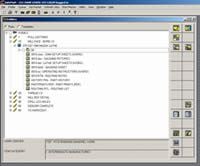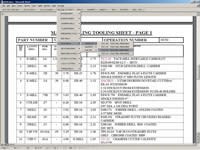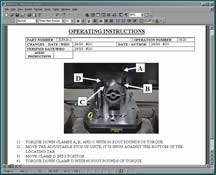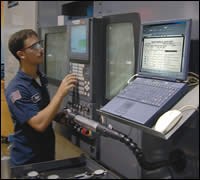The Knowledge System
This company sees knowledge to be a vital production resource. Capturing and sharing information are now routine functions on the shop floor. Here are lessons the company learned.
Share





When a company is young and small, there is little need for formal information sharing. Everyone in the company has easy access to all of the information they need. On the shop floor, a small group of production employees works side by side, inventing and improving the production process as they go.
But as the company grows, manufacturing job functions become more specific. A growing share of employees are newer hires who don’t necessarily know the context for the work they are asked to do or the procedures that make the most sense for the process. If these employees lack clear instruction, then the rate or quality of the output may vary significantly depending on which employees are doing the work that day. The same lack of formal structure that made the company so responsive when it was small can make the process clumsy and unpredictable when the company gets bigger. In other words, a manufacturer can choke on its own success.
One manufacturer that is determined to avoid that very danger is Task Force Tips of Valparaiso, Indiana. Company president Stewart McMillan intends for the company to be just as responsive, innovative and efficient at a size of 130 employees as it was when the company was small. He recognized, however, that fundamental changes would be needed to make this possible. Valuable knowledge locked up in the heads, computers and filing cabinets of key employees had to be shared across the workforce, among employees who can no longer be assured of interacting with one another on a daily basis. A brand-new infrastructure had to be put in place for sharing this information. And new procedures had to be adopted to make knowledge capture and knowledge transmission into routine functions of the company’s work.
The changes have been particularly dramatic on the production floor. Machine shop personnel now look to PCs near the machine tools for all of the information they need to set up, run, inspect and track any part. More significantly, the company devotes engineering resources simply to creating these instructions and making them as clear and effective for the operators as possible. Many of the changes that TFT is making throughout the company are still ongoing, but this system for sharing knowledge on the shop floor is already in place, and is already delivering benefits. Not only is the production process faster and more reliable thanks to this system, but the company itself is also more adaptable, because new part designs can now be introduced into production more easily. This last advantage is particularly important to TFT, because the company innovates so frequently that new part numbers are added to the process every week.
The Company
TFT makes equipment used by firefighters. Machining and assembly are performed in two Valparaiso facilities. About 10,000 active part numbers are machined on various Mazak machining centers and multitasking lathes.
The company’s first product was a fire hose nozzle able to maintain a constant water pressure despite fluctuating pressure in the hose. That product was introduced by Mr. McMillan’s father, Clyde McMillan. Today, the company offers a range of products for the firefighting field including not only nozzles and fire hose appliances, but also foam application systems and hand tools that are customized for fire and rescue work.
New product development—that is, ongoing new product development—is the cornerstone of the company’s strategy for continued success. TFT can’t afford ever to fall back on its current product line, because to do so would leave the company vulnerable to competitors who can make lower-quality copies of its products for much less.
The Problems
The reader of this article may also work for a manufacturing company that has 100 or more employees. If so, the challenges that TFT set out to address may sound very familiar. Those challenges include:
- Regular turnover. A clean work environment and an optimistic culture keep the workforce stable at TFT, but even so, a workforce of a certain size sees employees coming and going all of the time. On TFT’s shop floor, there are always new faces.
- New hires with low skills. The company can no longer count on filling its openings with employees who have well-developed manufacturing skills. Often the company must rely on candidates who are inexperienced but willing to learn, and who are capable of learning on the job.
- Inefficiency caused by paper. Hard-copy part prints and work instructions become steadily more difficult to use as the size of the machine shop grows. An employee may lose time searching for a part print that some other employee is using. Even more time may be lost if the employee scraps a part by working from an old version of a print that has since been revised.
- Inefficient setups. Productivity used to vary dramatically at TFT because operators had different levels of proficiency at setting up different jobs. Some operators knew only how to set up certain part numbers. The entire process could become more productive, if only all of the operators could simultaneously be instructed in the best way to set up every part.
The Solution
Today, all of the information that a TFT operator needs to perform a job is available at a PC close to the machine tool’s control. In addition, all of the information that an operator needs to share, for the value of the overall process, can be entered or captured at that same PC.
The operator begins by selecting a part number. This selection starts the clock. Production time data invisibly captured in this way allow TFT to evaluate the performance of its machines and its processing strategies. The data captured are far more accurate now than what the company formerly used when production times were recorded by hand.
Once the operator has selected a part number, a tree-structured menu offers separate branches for every step in the machining sequence associated with the part. Clicking on any of these steps reveals sub-branches for all of the electronic documents relevant to that step, including setup instructions, gaging instructions, part prints and even the history of internal correspondence related to that part. For all of the shop’s part numbers, a given part might have five to ten machining steps associated with it, and every step might have five to ten relevant documents.
Two software tools make it possible to share and organize so much information. One is a suite of shop management applications collectively called “Folders” from Cimnet Inc. The Folders system provides a structure specifically designed to give shopfloor personnel easy access to manufacturing documents—particularly when a large quantity and variety of documents are involved.
The other software tool the shop relies upon is Microsoft Word.
Word offers powerful features for creating documents that are meant to be viewed and shared electronically. For example, TFT’s shopfloor Word documents include digital camera photos to supplement the setup instructions. Also, a reference to a tool in these documents can be presented as a hyperlink that connects to information about that tool. And to ensure that every tool is referred to using a standard naming convention across every document, menus that have been customized in Word allow users simply to click on tool names in order to insert those names into the text—hyperlinks included.
Two employees from TFT’s production engineering group play important roles with regard to these documents. One is Jim Walker, a 21-year employee. Mr. Walker develops prototype machining processes for all of the company’s new parts. After the process for a new part is worked out, Dave Lewis steps in. An employee in his early 20s who came to the company when he was 17, Mr. Lewis is comfortable with both the machine shop and the finer points of Word. He created the custom menus for inserting tool names, for example. For each process developed by Mr. Walker, Mr. Lewis documents the process, takes digital photos, and creates all of the necessary documents for inclusion in the Cimnet system.
(Mr. Lewis is also an example of one of the company’s responses to the lack of skilled employees. He came to TFT out of high school by means of the company’s apprenticeship program. Nine current employees came through this program.)
The new system that relies on these electronic documents replaces the use of hard-copy prints and instructions on the shop floor. Hard copies are difficult to share and difficult to keep current. In TFT’s case, hard copies also left the company vulnerable, because a fire, flood or act of vandalism could have wiped out the company’s institutional knowledge about how to manufacture parts.
However, the new system provides more than just dumb terminals for viewing documents. The ability of shopfloor personnel to share information, right at the machine, is an equally important characteristic. Mr. Walker and Mr. Lewis point to these other features of the system:
- Shopfloor personnel can edit job-related documents as needed. Revisions are automatically routed to Mr. Walker, who reviews changes before they become official.
- A “shift report” feature lets an operator leave a message for the next operator who will work on a particular job. TFT runs two 10-hour shifts, and this electronic reporting feature is now the principal means by which the separate shifts communicate with one another.
- Programs can be launched out of the Cimnet system. For example, TFT’s system will automatically launch Griffo Brothers software for managing Mazatrol NC files whenever a program is sent to a Mazak machine.
- Commonly used utilities and data tables are now stored on the system, too. TFT uses a small number of standard toolholders, for example, and every standard toolholder has a particular set of offsets for each machine. Data such as these used to be found on sheets of paper affixed to every machine. Now the information is available electronically.
Lessons Learned
What TFT achieved with the new system goes beyond just a move from hard-copy to digital information. The engineered instruction sheets, the structuring of information according to operation, the access to part history and even the clear channel of communication between shifts—all of these features represent a change in the quality of information available to employees. The transition, a change being made throughout TFT, can be thought of as the move from tribal knowledge to system knowledge. Information in the past was stored in various “silos.” An employee in need of information had to physically visit one of those silos and then make sense of what he found. The objective today is to throw open the silos, not just by networking silos together, but also by formatting the information so that anyone in the company can use it productively.
Mr. McMillan, Mr. Walker and Mr. Lewis all spoke about the experience of making this transition. Here are some of the lessons they learned and the advice they would give to other shops that want to see their own internal knowledge used better:
-
Don’t hold back on hardware.
Computing hardware needs to be abundant enough that any employee can find an open PC when necessary. It also has to be fast enough that employees can use it without having to suffer through a delay. Spend money on this, Mr. McMillan says. “If the system is too slow or difficult, they won’t use it.” Instead, they will scratch notes to themselves and find other work-arounds that defeat the system’s intent. -
Dismantle silos.
Mr. McMillan says the number-one reason why employees tend to hoard information is the fear that other employees won’t be able to use the information correctly. They think a little knowledge is a dangerous thing, in other words. The problem with this thinking is that the siloing “solution” is worse than the problem. A better solution may be to present the information in a form that is more complete and easier to understand. But even when there is a danger of misunderstanding, Mr. McMillan says “no amount of screwing up” can compare with the inefficiency that comes from information being withheld.The siloing may not even involve a physical separation. Naming conventions for electronic files need to be chosen carefully to maximize employee access. If information is stored on the network but other employees don’t know where to look for it, then the result is simply the electronic equivalent of the locked filing cabinet. -
Transition as you go.
For existing part numbers, Mr. Walker and Mr. Lewis converted the hard-copy information into electronic files only as the jobs were run. There were two reasons to proceed in this way. First, employees running the jobs would see the new electronic documents as they were created, allowing them to better understand the transition and offer their input. Second, converting part numbers as they ran prevented wasting time on obsolete parts. Certain part numbers may never need to be captured electronically, because those parts belong to products that are no longer in demand. -
Endure grumbling.
Resistance to change is a part of human nature. In any large-enough group involved in a change, a certain number will give voice to their discomfort. The grumbling does not necessarily mean that the change is bad. On the other hand, enduring this grumbling is different from ignoring it. Sometimes a useful criticism may arrive in the form of a gripe.Mr. Lewis thinks the best response is simply to take the grumbling at face value. “If someone tells me, ‘This is a joke,’” he says, “then I listen closely and I ask, ‘Then how do we make it better?’” -
Recognize the value of inexperience.
An employee without preconceptions can be a valuable resource during times of transition. For example, TFT’s tool management area now uses electronic tool setup sheets comparable to the setup sheets used for each part. The employee who created those sheets had less experience setting tools than other employees around him. This relative inexperience actually proved to be an asset. He included information in his instructions that other employees might have left out because they knew the procedures so well. -
Be ready to learn as you go.
TFT was invested in a convention for naming files on the new system when it discovered that this convention was not broad enough or flexible enough to cover the entire range of files that needed to be converted. The solution was either to doctor the convention halfway through, and hope employees would remember the patch, or else to begin again with an entirely new convention that would be intuitive all the way through. To Mr. McMillan, it was no contest. He had employees begin again from scratch.
Another insight that came in mid-process affected how broadly the shopfloor network was applied. This network had been conceived only for use in machining. But in an “aha” moment, says Mr. McMillan, company personnel realized that the instruction sheets made even more sense for assembly. Today the assembly knowledge has also been systemized, and PCs can be found near each assembly station.
Prepare For Success
One source of inspiration that Mr. McMillan keeps close at hand is a poster that bears the quote, “If I had known I was going to live this long, I would have taken better care of myself.”
Task Force Tips is a business that has lived that long. Mr. McMillan is determined that it will live longer.
And that brings him to another piece of advice: Start early. The most important feature of TFT’s current process is that it anticipates newness. New parts, new opportunities, new employees—the process can accommodate all of these changes. More importantly, the system was designed from the ground up to expect such changes, and to accommodate them as a matter of course.
Prepare for success, says Mr. McMillan. Design the system not just to meet today’s needs but also to respond to the needs of tomorrow—whenever it is that tomorrow’s needs happen to appear.
Related Content
Solve Worker Shortages With ACE Workforce Development
The America’s Cutting Edge (ACE) program is addressing the current shortage in trained and available workers by offering no-cost online and in-person training opportunities in CNC machining and metrology.
Read MoreIn Moldmaking, Mantle Process Addresses Lead Time and Talent Pool
A new process delivered through what looks like a standard machining center promises to streamline machining of injection mold cores and cavities and even answer the declining availability of toolmakers.
Read MoreInside Machineosaurus: Unique Job Shop with Dinosaur-Named CNC Machines, Four-Day Workweek & High-Precision Machining
Take a tour of Machineosaurus, a Massachusetts machine shop where every CNC machine is named after a dinosaur!
Read MoreWorkholding Fixtures Save Over 4,500 Hours of Labor Annually
All World Machinery Supply designs each fixture to minimize the number of operations, resulting in reduced handling and idle spindle time.
Read MoreRead Next
Setting Up the Building Blocks for a Digital Factory
Woodward Inc. spent over a year developing an API to connect machines to its digital factory. Caron Engineering’s MiConnect has cut most of this process while also granting the shop greater access to machine information.
Read MoreRegistration Now Open for the Precision Machining Technology Show (PMTS) 2025
The precision machining industry’s premier event returns to Cleveland, OH, April 1-3.
Read MoreBuilding Out a Foundation for Student Machinists
Autodesk and Haas have teamed up to produce an introductory course for students that covers the basics of CAD, CAM and CNC while providing them with a portfolio part.
Read More
























.jpg;maxWidth=300;quality=90)









